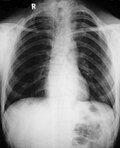Cleidocranial dysostosis

Editor-In-Chief: Prab R Tumpati, MD
Obesity, Sleep & Internal medicine
Founder, WikiMD Wellnesspedia &
W8MD medical weight loss NYC and sleep center NYC
| Cleidocranial dysostosis | |
|---|---|

| |
| Synonyms | Cleidocranial dysplasia, Marie-Sainton syndrome |
| Pronounce | |
| Specialty | Medical genetics |
| Symptoms | Delayed closure of cranial sutures, absent clavicles, dental abnormalities |
| Complications | Hearing loss, scoliosis, respiratory issues |
| Onset | Congenital |
| Duration | Lifelong |
| Types | |
| Causes | Genetic mutation in the RUNX2 gene |
| Risks | |
| Diagnosis | Clinical examination, genetic testing |
| Differential diagnosis | Pycnodysostosis, osteogenesis imperfecta |
| Prevention | |
| Treatment | Orthodontic treatment, surgery |
| Medication | |
| Prognosis | Generally good with treatment |
| Frequency | 1 in 1,000,000 |
| Deaths | |
Cleidocranial dysostosis (CCD), also known as Cleidocranial dysplasia, is a rare genetic disorder primarily affecting bone and dental development. It is inherited in an autosomal dominant manner, typically resulting from mutations in the RUNX2 gene<ref>,
Cleidocranial dysplasia, Orphanet Journal of Rare Diseases, 2006, Vol. 1(Issue: 1), pp. 15, DOI: 10.1186/1750-1172-1-15, PMID: 16722557,</ref>.
Clinical Presentation[edit]
Characteristics of CCD include skeletal and dental abnormalities. The most characteristic features are underdeveloped or absent clavicles (collar bones), which results in individuals being able to bring their shoulders together in front of their body. Dental anomalies, including delayed loss of primary teeth and delayed eruption of secondary teeth, are common. Other features include delayed or incomplete closure of the fontanelles, a prominent forehead, wide-set eyes (hypertelorism), a flat nose, and a short stature. Spinal abnormalities, such as scoliosis, may also occur<ref>,
GeneReviews. online version, University of Washington, Seattle, 2018,</ref>.
Genetics[edit]
CCD is caused by mutations in the RUNX2 gene, located on chromosome 6p21. RUNX2 is essential for the development of osteoblasts, the cells responsible for bone formation<ref>,
CBFA1, a candidate gene for cleidocranial dysplasia syndrome, is essential for osteoblast differentiation and bone development, Cell, 1997, Vol. 89(Issue: 5), pp. 765-771, DOI: 10.1016/S0092-8674(00)80259-7, PMID: 9182762,</ref>.
Diagnosis and Management[edit]
Diagnosis of CCD is primarily based on clinical examination and radiographic findings, but can be confirmed by genetic testing. Management of CCD is mainly supportive and involves a multidisciplinary approach, including orthopedic management for skeletal anomalies and dental interventions for oral health.
Gallery[edit]
-
Cleidocranial dysostosis
-
Cleidocranial dysostosis
-
Cleidocranial dysostosis
-
Cleidocranial dysplasia teeth
-
Cleidocranial dysostosis
See Also[edit]
References[edit]
<references />
|
|
|
NIH genetic and rare disease info[edit]
Cleidocranial dysostosis is a rare disease.
| Rare and genetic diseases | ||||||
|---|---|---|---|---|---|---|
|
Rare diseases - Cleidocranial dysostosis
|
Ad. Transform your life with W8MD's Budget GLP-1 injections from $75


W8MD offers a medical weight loss program to lose weight in Philadelphia. Our physician-supervised medical weight loss provides:
- Weight loss injections in NYC (generic and brand names):
- Zepbound / Mounjaro, Wegovy / Ozempic, Saxenda
- Most insurances accepted or discounted self-pay rates. We will obtain insurance prior authorizations if needed.
- Generic GLP1 weight loss injections from $75 for the starting dose.
- Also offer prescription weight loss medications including Phentermine, Qsymia, Diethylpropion, Contrave etc.
NYC weight loss doctor appointmentsNYC weight loss doctor appointments
Start your NYC weight loss journey today at our NYC medical weight loss and Philadelphia medical weight loss clinics.
- Call 718-946-5500 to lose weight in NYC or for medical weight loss in Philadelphia 215-676-2334.
- Tags:NYC medical weight loss, Philadelphia lose weight Zepbound NYC, Budget GLP1 weight loss injections, Wegovy Philadelphia, Wegovy NYC, Philadelphia medical weight loss, Brookly weight loss and Wegovy NYC
|
WikiMD's Wellness Encyclopedia |
| Let Food Be Thy Medicine Medicine Thy Food - Hippocrates |
Medical Disclaimer: WikiMD is not a substitute for professional medical advice. The information on WikiMD is provided as an information resource only, may be incorrect, outdated or misleading, and is not to be used or relied on for any diagnostic or treatment purposes. Please consult your health care provider before making any healthcare decisions or for guidance about a specific medical condition. WikiMD expressly disclaims responsibility, and shall have no liability, for any damages, loss, injury, or liability whatsoever suffered as a result of your reliance on the information contained in this site. By visiting this site you agree to the foregoing terms and conditions, which may from time to time be changed or supplemented by WikiMD. If you do not agree to the foregoing terms and conditions, you should not enter or use this site. See full disclaimer.
Credits:Most images are courtesy of Wikimedia commons, and templates, categories Wikipedia, licensed under CC BY SA or similar.
Translate this page: - East Asian
中文,
日本,
한국어,
South Asian
हिन्दी,
தமிழ்,
తెలుగు,
Urdu,
ಕನ್ನಡ,
Southeast Asian
Indonesian,
Vietnamese,
Thai,
မြန်မာဘာသာ,
বাংলা
European
español,
Deutsch,
français,
Greek,
português do Brasil,
polski,
română,
русский,
Nederlands,
norsk,
svenska,
suomi,
Italian
Middle Eastern & African
عربى,
Turkish,
Persian,
Hebrew,
Afrikaans,
isiZulu,
Kiswahili,
Other
Bulgarian,
Hungarian,
Czech,
Swedish,
മലയാളം,
मराठी,
ਪੰਜਾਬੀ,
ગુજરાતી,
Portuguese,
Ukrainian







